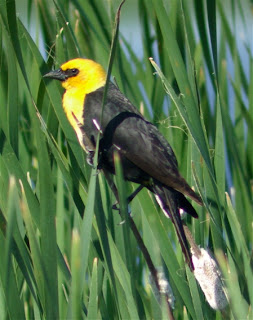From the Associated Press:
By JAMES MacPHERSON
BISMARCK, N.D. (AP) — Federal wildlife officials will target entire parcels of cattail-choked wetlands in North Dakota this year to kill the preferred habitat of sunflower-scarfing blackbirds.
Some 60,000 acres of cattail marshes in North Dakota have been destroyed since 1991 to try to keep blackbirds at bay, said Phil Mastrangelo, state director for the U.S. Department of Agriculture's Wildlife Services agency.
Last year in North Dakota, about 4,500 acres of wetlands in 16 counties were treated, Mastrangelo said. This year there will be enough money to treat about 8,000 acres, he said.
A herbicide is applied from a helicopter, at a cost to the government of about $23 an acre, Mastrangelo said. The program targets only cattails on private land and is free to sunflower farmers. Last year, 43 of them got treatment.
In past years, about 70 percent of a cattail marsh was treated with a herbicide, but blackbirds were still able to nest, loaf and roost in the remaining fuzzy-topped weeds with reedlike leaves. "That 30 percent still gave some heartburn from the blackbirds," Mastrangelo said.
The USDA estimates blackbirds eat more than $10 million worth of sunflowers each year in North Dakota, which accounts for about half of the nation's sunflower production.
"Just getting rid of cattails is a real good tool to use," said Mike Clemens, a sunflower farmer from Wimbledon, in eastern North Dakota. "If you can get rid of them within two miles of a field, blackbirds will go somewhere else to find something else to chew on."
Clemens, who has used the program for two years, said eradicating all the cattails in an area is important. "If you leave 10 percent of cattails, it's still just enough to attract birds who will still want to hang around," he said.
Some 70 million blackbirds come through the Northern Plains each year, including about 6 million that stop in North Dakota, biologists say. Each blackbird can eat about an ounce of sunflower seeds daily.
Larry Kleingartner, executive director of the Bismarck-based National Sunflower Association, said cattail eradication has been effective in controlling blackbirds. He said the loss of habitat makes the blackbirds more vulnerable to predators during nesting.
Cattails cover some 600,000 acres of wetlands in North Dakota. Mastrangelo said wetlands treated with the herbicide are typically free of cattails for about five years.



